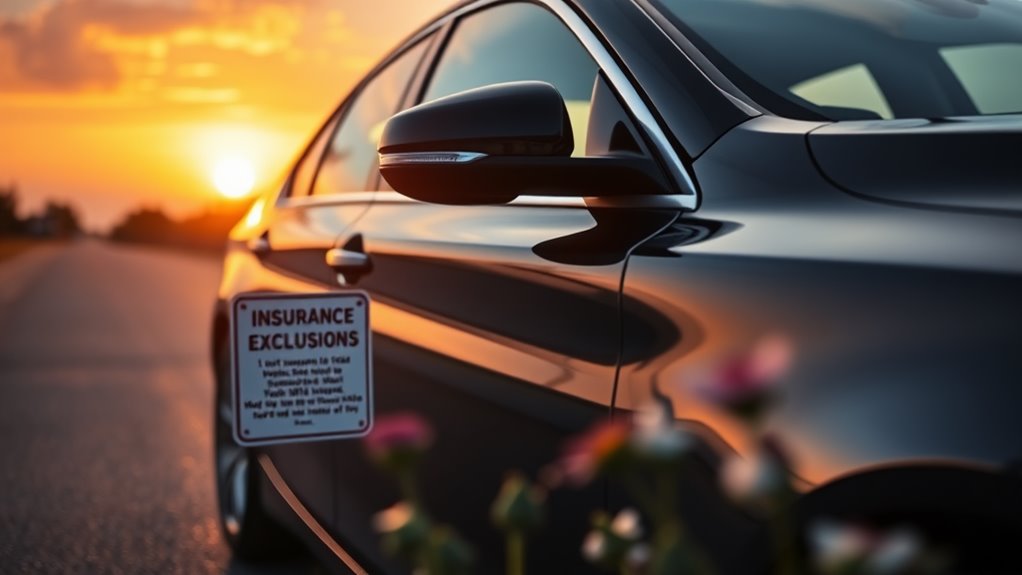When considering non-owner car insurance, it's crucial to understand its limitations. You might think you're fully covered, but certain exclusions could leave you vulnerable. For instance, the policy doesn't cover vehicles owned by household members, business use, or damages to borrowed cars. Each of these exclusions has significant implications for your financial protection. So, what do these restrictions really mean for your driving habits and responsibilities?
Key Takeaways
- Non-owner car insurance excludes coverage for damages to vehicles owned by household members, leaving them unprotected in accidents.
- The policy does not cover damages or theft of borrowed vehicles, limiting liability protection in those situations.
- Excluded drivers are not covered under the policy, potentially leaving the policyholder liable for damages caused by them.
- Non-owner insurance is not applicable for business use of vehicles, meaning any related incidents are uninsured.
- High-risk driving situations may not be covered unless specifically stated, which can result in significant financial risks.
Coverage Limitations for Vehicle Damage

While non-owner car insurance provides essential liability coverage, it's important to understand its limitations regarding vehicle damage.
Primarily, these policies lack collision and extensive coverage, meaning any damage to the vehicle you're driving isn't covered. If you're at fault in an accident, you're responsible for the vehicle's damage, which would fall under the vehicle owner's policy if they've collision coverage. This type of insurance typically includes the minimum required coverage based on state laws, which may not be sufficient in all scenarios. Additionally, understanding the coverage options available can help bridge these financial gaps.
This creates potential financial gaps, so it's significant to evaluate additional coverage options. Although non-owner policies typically come with lower premiums and no deductibles, relying solely on this insurance can leave you vulnerable in high-cost accident scenarios.
Excluded Drivers and Their Impact
Understanding the limitations of non-owner car insurance also involves recognizing the implications of excluded drivers. Excluded drivers are specifically named individuals who aren't covered by the policy, often due to their high-risk status.
While this exclusion helps limit your liability, it also comes with potential downsides. If an excluded driver operates a vehicle, they face legal issues similar to driving uninsured. You could also be held liable for damages caused by their actions.
Additionally, excluded drivers typically must secure separate insurance, as they can't drive any vehicle under your policy. The impact of excluding high-risk drivers generally reduces your overall risk but requires careful management to avoid potential financial and legal repercussions.
Restrictions on Vehicle Types and Uses
Non-owner car insurance comes with specific restrictions that limit its applicability based on the type and use of vehicles. This policy typically excludes coverage for vehicles owned by household members, making it unnecessary if you frequently drive their cars.
Additionally, non-owner insurance doesn't cover business use, which means if you're using a vehicle for work, you'll need a different policy. You also won't be protected against damages or theft of the borrowed vehicle, as there's no extensive or collision coverage included.
High-risk driving situations may not be covered unless specified. Ultimately, understanding these restrictions is essential for ensuring you have the right coverage for your driving needs.
Conclusion
In summary, understanding the exclusions of non-owner car insurance is essential to avoid unexpected liabilities. Many might assume they're fully covered while driving borrowed vehicles or using cars for work, but these policies fall short in those areas. By recognizing these limitations, you can make informed decisions about additional coverage, ensuring you're protected in various driving scenarios. Don't let misconceptions lead to financial pitfalls; always verify your insurance details before hitting the road.





